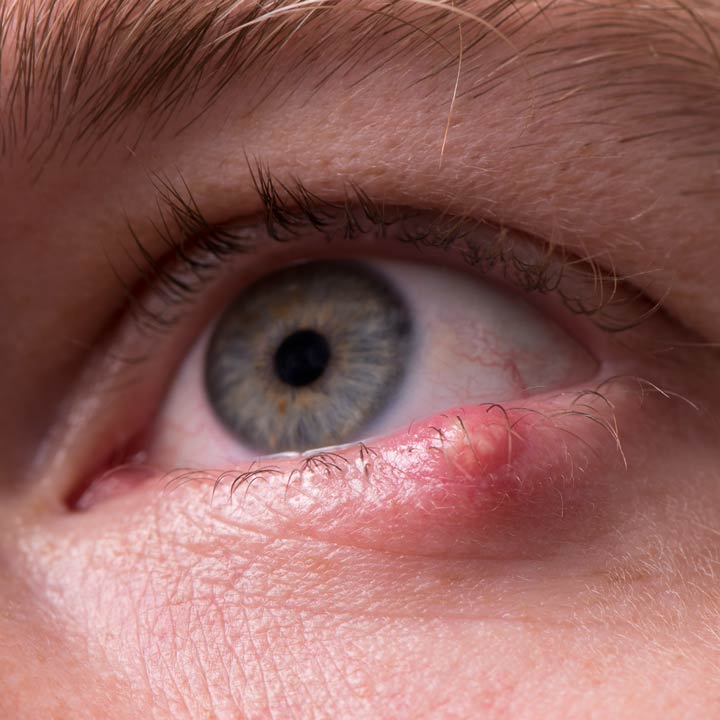What are styes?
 Styes (also known as chalazia) are bumps in or along the edge of an eyelid. The bumps may be red, painful or irritating, but are rarely serious. Most go away on their own without treatment.
Styes (also known as chalazia) are bumps in or along the edge of an eyelid. The bumps may be red, painful or irritating, but are rarely serious. Most go away on their own without treatment.
What causes styes?
A stye forms when an oil gland in your eyelid becomes blocked. Oil glands can become blocked due to:
- Hormonal changes
- Stress
- Diet changes
- Lack of sleep
Styes may also be connected to blepharitis, or dry eye, a condition that causes inflammation of the eyelids.
If you have rosacea, meibomian gland dysfunction (MGD), hormonal acne, are pregnant, or take medication with treitnoin (like Accutane®), you may be more susceptible to getting styes.
How do you prevent styes?
Lifestyle changes can help prevent styes, such as:
- Regularly washing your eyelashes/lash line with baby shampoo
- Eating more leafy greens
- Using omega-3 daily fish oil supplements
- Maximizing good sleep
Your physician may provide step-by-step eyelid hygiene instructions, prescribe antimicrobial eyelash spray and prescribe oral antibiotics, if needed.
Symptoms and diagnosis
A stye forms along the edge of your upper or lower eyelid and usually starts as a red bump. It swells larger and become hard as the surrounding area becomes inflamed. It can be painful or cause your eyes to water. Pimples usually don’t form around the lash line, so styes are distinguishable.
Typically, styes disappear on their own within one week. If you have a stye that continues to grow, is re-inflamed or never goes away, contact your doctor. A physical exam from an oculofacial ophthalmologist can help you find the best treatment plan and rule out infection or, in rare cases, skin cancer.
How to treat a stye
Most styes can be treated at home with a warm compress for five to 10 minutes, three to six times a day. Don’t squeeze or pop a stye or cover it up with makeup.
A persistent stye (chalazion) may require prescription eye ointments or drops, oral antibiotics, a steroid injection or, in extremely rare cases, hospitalization with intravenous antibiotics to treat a secondary infection.
If a stye has persisted for a couple of weeks or becomes hard to the touch, you may need to have it drained or surgically removed.
Intense pulsed light (IPL) therapy can be used to treat underlying rosacea and MGD, both common causes of styes. Ask your doctor if IPL treatment is right for you.
Surgery to remove styes
If nonsurgical treatments were unsuccessful, your doctor may consider surgical alternatives to remove your stye. Surgical removal of a stye starts with flipping the eyelid. A small incision is made to the inside of the eyelid to drain the oil and pus. Scar tissue may also be cut out to decrease the reoccurrence of another chalazion forming. The surgery takes 15 to 20 minutes to perform.
Some surgeons may drain the stye but choose against removing scar tissue. However, our experts perform stye surgery more than 20 times a month, giving our oculofacial surgeons expertise in handling eyelid anatomy and confidence in the safest techniques for the removal of scar tissue.
Postsurgery recovery
After surgery, the incision is left open to continue draining the wound. You may have a pink tinge on your eye or pink tears for up to four hours after surgery. Your doctor may place a patch over the eye for comfort following surgery. While healing, you doctor will provide some restrictions on what you typically do each day, including:
- Don’t wear eye makeup or contact lenses until the stye or chalazion heals, typically two weeks.
- Don’t share towels, pillows or washcloths while you are healing.
Your doctor may prescribe antibiotic eyedrops or ointments following surgery. If you’re on antibiotics, remember to finish the full prescribed course of the medication. Your eyelid can appear better but may not be completely healed under the surface.
If the stye worsens or doesn’t seem to be healing properly after surgery, contact your doctor’s office.
Is treatment covered by insurance?
As treatment for a medical condition, procedures to remove styes (chalazia) are typically covered by accepted insurance. Please check with your doctor’s office or insurance provider for details.
Why choose the Ohio State oculofacial team
Our oculofacial physicians are the only specialized experts in the care, diagnosis, treatment and surgery for facial eye plastics at The Ohio State University Wexner Medical Center. Every member of our oculofacial team is board certified and has completed a two-year fellowship in eye plastics from the American Society of Ophthalmic Plastic and Reconstructive Surgery. There are only 750 physicians in the world with this comprehensive training (data as of January 2023).

